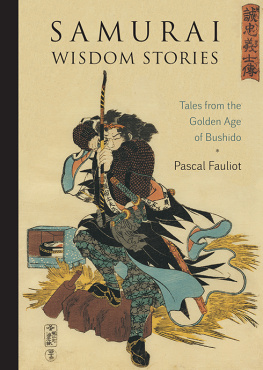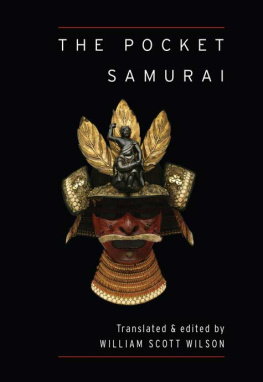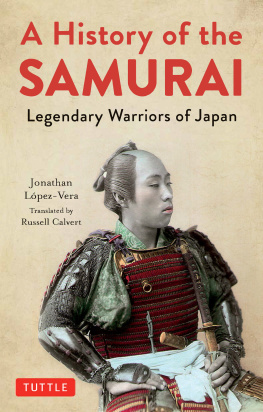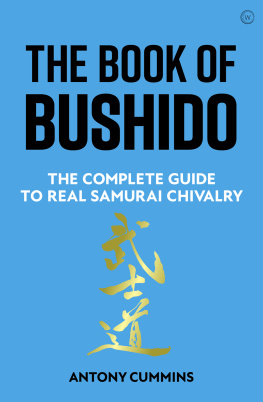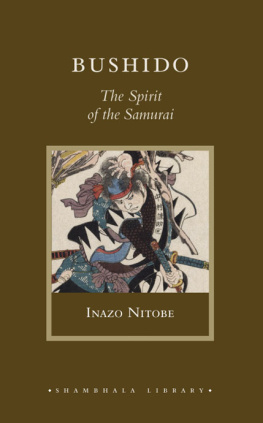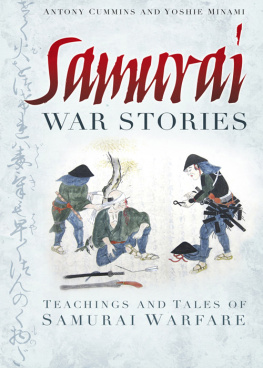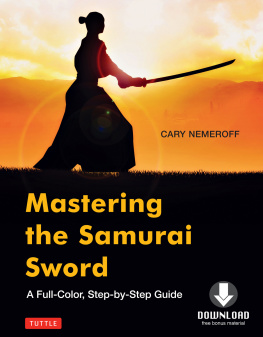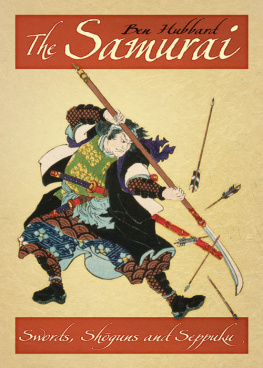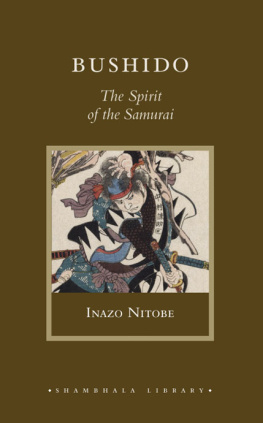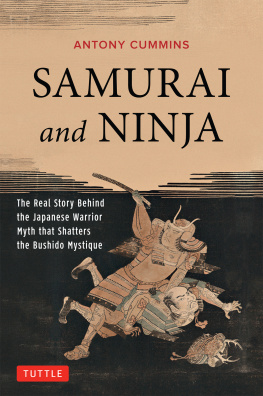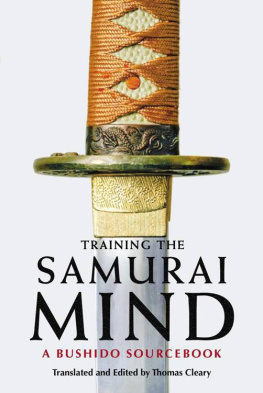Sign up to receive news and special offers from Shambhala Publications.

Or visit us online to sign up at shambhala.com/eshambhala.
Samurai Wisdom Stories
TALES FROM THE GOLDEN AGE OF BUSHIDO
Pascal Fauliot
TRANSLATED BY SHERAB CHDZIN KOHN

Shambhala
BOULDER | 2017
Shambhala Publications, Inc.
4720 Walnut Street
Boulder, Colorado 80301
www.shambhala.com
English translation 2017 by Shambhala Publications, Inc.
First published in France under the title Contes des sages Samoura by Pascal Fauliot, 2011, ditions du Seuil
Cover art: Mase Chday masa-aki reproduced courtesy of the David R. Weinberg Collection, photograph by E. G. Schempf
All rights reserved. No part of this book may be reproduced in any form or by any means, electronic or mechanical, including photocopying, recording, or by any information storage and retrieval system, without permission in writing from the publisher.
LIBRARY OF CONGRESS CATALOGING-IN-PUBLICATION DATA
Names: Fauliot, Pascal, author.
Title: Samurai wisdom stories: tales from the golden age of Bushido / Pascal Fauliot; translated by Sherab Chdzin Kohn.
Other titles: Contes des sages Samouras. English
Description: Boulder, CO: Shambhala Publications, Inc., 2017. | First Edition.
Identifiers: LCCN 2016030875 | eISBN 9780834840751 | ISBN 9781611804133 (pbk.: alk. paper)
Subjects: LCSH: SamuraiAnecdotes.
Classification: LCC DS827.S3 F3813 2017 |DDC 952/.025dc23
LC record available at https://lccn.loc.gov/2016030875
To Jacques Normand,
My master of budo,
Shihan of kyudo and naginata-jutsu,
Pioneer of the traditional martial arts in Europe.
CONTENTS
I HAD THE GOOD FORTUNE of being able to practice with Jacques Normand Sensei from the time I was a teenager. He was one of the first Europeans to live in Japan and study the martial arts in an intensive manner there. In 1969, he took up residence in Shizuoka. Being a very passionate and tough individual, he trained nearly forty hours a week in various disciplines. After many years he returned to France having mastered the fighting arts for most of the samurai weaponsthe sword, bow, naginata (halberd), yari (lance), the different kinds of staff, kusarigama (sickle and chain)as well as the techniques of barehanded fighting, including karate and aikido, and the ancient sword dances (kenbu). This made him one of the few people in the world to have mastered almost as many martial arts as the samurai of olden times. He is also one of the first Westerners to have been accepted into the koryu, the ancient schools of the Japanese martial arts. In this way he became qualified to receive menkyo kaiden (transmission of secret knowledge) and to obtain the prestigious title of shihan, which proclaims a practitioner to be a master of the budo tradition.
It was Jacques Normand Sensei who made it possible for me to work closely with Tokuda Masahiko Sensei, a soke, a grand master, the twenty-first head and holder of the transmission lineage of the Heki Ryu Insai Ha, whose origins go back to the fifteenth century. He is an exceptional teacher whose profound understanding of kyujutsu (the art of the bow) and whose erudition are equaled only by his simplicity and compassion. A master of this level is the very incarnation of the spirit of budo, the spiritual Way of the traditional martial arts. This Way is fully steeped in both Shintoism and Buddhism. It is true ritsu zen, which literally means standing meditation, but in reality is more like meditation in motion. This Way is also followed in the other arts practiced by the monks and bushi, such as calligraphy, painting, tea ceremony, and others.
Ken zen ichinyo, says the adage, The sword and Zen are one. Butsudo (the Way of the Buddha) and budo were closely intertwined in the glory days of the samurai. This was so much the case that it was typical for warriors of all ranks to take the minor monastic vows of Buddhism but continue their work in this floating world as practicing Buddhist laymen, the equivalent of lay Christian brothers, before finally retiring to a monastery or hermitage. Thus the illustrious lords Takeda Shingen and Uesugi Kenshin are often depicted with their heads shaven or wearing a religious cap, with a monks bag over the shoulder, and holding a rosary in one hand and a sword or fan of command in the other.
Personally, I have always been very taken by the beauty of movements that manifest the inner state of the practitioner. A movement has a sound, and a kata (a codified series of movements) is like a melody in the way it is composed, in its rhythm, and in the way it is interpreted. Every manifestation is a reflection of kokoro, of the soul of the person who is manifesting. In kyudo, the Way of the Bow, the master does not even need to watch the archer who is shooting. He hears the song of the bow, and that is enough to let him perceive the quality of the shot. The sound of the string causing the bamboo to vibrate, the whistling of the arrow, its impact on the targetall these factors speak. Meditation in movement is the goal. An awakened mind enables the practitioner to enter into the resonance of the cosmic Awareness. The great Zen master Hakuin said that meditation in the midst of action is a thousand times superior to motionless contemplation.
The practitioner of this art must submit to his training with respect, discipline, and humility. He must subject himself to a veritable ascesis: the unrelenting repetition of a movement in the work of polishing it and at the same time perfecting oneselfall under the strict eye of ones master. Jacques Normand has always stressed the importance of the body in action:
Movements that are executed correctly allow the body to relax, to flourish. The first phase is corrective: the spine straightens up, the shoulders sink down, tensions fall away, and the breath recovers its natural rhythm. Once this work of restoration is complete, the person is at the point where he or she can develop harmoniously. Genuine meditation in movement, dynamic yoga, the art of the gesture, brings about an intimate connection between body and mind that results in the progressive opening of the chakras, the subtle centers of the body. The art of physical movement has the effect of recharging ones energy. The goal one pursues here is to fill oneself within with magnetic potentiality that is as balanced as it can possibly be.
This process of self-perfection is in reality a process of stripping away. This is because the aim of it is to reach satori, Awakeningto realize kensho, the vision of ones true nature. No doubt it is a quest for inner liberation, but for the purpose of serving something greater than oneself. Etymologically, the samurai is one who serves, a servantin the sense of a servant of the state or the servant of a temple. The samurai is the peacemaker who reestablishes and maintains the balance of a feudal domainor of the world. In Japanese mythology, the gods themselves utilize the noble weapons of the bushithe bow, the sword, the naginatato fight the demons, to restore the primordial harmony, to pacify the earth. These are the same weapons that are used by masters of the martial arts in purification rituals, exorcisms, and rites of healing. In the traditional perspective, everything is intimately linked with everything else.
The adept of budo, in mastering himself, can also contribute to the pacification of the world. By controlling his energies, he can reach a state where another energy can act through him. Indeed, it is fascinating to see or to feel this other dimension at work within oneself. It is remarkable to experience this energy that is the vehicle, support, and sustainer of the practitioners efforts and that seems to transfigure the practitioner by its movement. Sometimes a master of advanced age can appear during a demonstration of his art to enter into a state of weightlessness, of grace, sustained by ki, inner energy, whereas in his daily life he is crippled by rheumatism and moves about only with difficulty.
Next page
